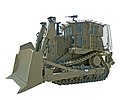
Heavy equipment, heavy machinery, earthmovers, construction vehicles, or construction equipment, refers to heavy-duty vehicles specially designed to execute construction tasks, most frequently involving earthwork operations or other large construction tasks. Heavy equipment usually comprises five equipment systems: the implement, traction, structure, power train, and control/information.
Contents
- Innovations and new technologies
- Fleet telematics and monitoring
- Autonomy and robotics
- Operator safety and assistance
- Electrification
- Types
- Images
- Implements and hydromechanical work tools
- Traction: Off-the-road tires and tracks
- Heavy equipment operator
- Equipment cost
- Ownership cost
- Operating cost
- Models
- Notable manufacturers
- See also
- References
- External links
Heavy equipment has been used since at least the 1st century BC, when the ancient Roman engineer Vitruvius described a crane powered by human or animal labor in De architectura .
Heavy equipment functions through the mechanical advantage of a simple machine that multiplies the ratio between input force applied and force exerted, easing and speeding tasks which often could otherwise take hundreds of people and many weeks' labor. Some such equipment uses hydraulic drives as a primary source of motion.
The word plant, in this context, has come to mean any type of industrial equipment, including mobile equipment (e.g. in the same sense as powerplant). However, plant originally meant "structure" or "establishment" – usually in the sense of factory or warehouse premises; as such, it was used in contradistinction to movable machinery, often in the phrase "plant and equipment".




















